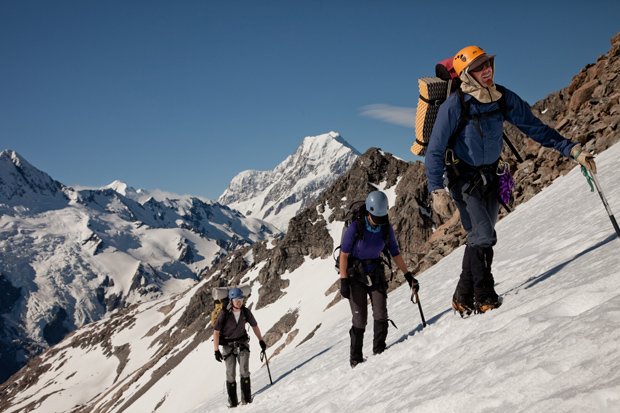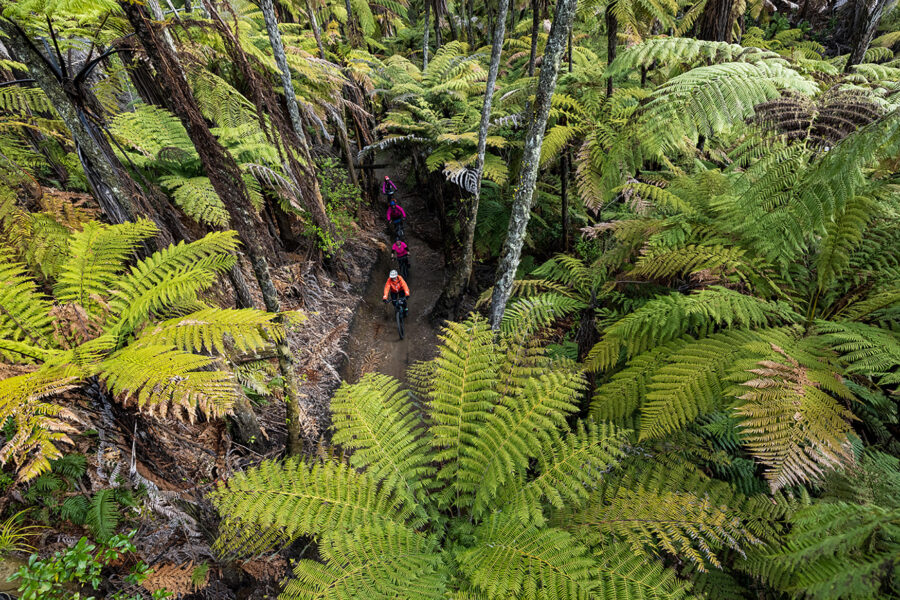Mountaineering on Mt Cook, New Zealand

A SMALL BEAD OF SWEAT rolls down my forehead as my white knuckles cling onto a small thread of tape attached to my harness. This tape has a knot in it tied by me and is the only thing stopping me from falling 100m to my peril onto the rocks below.
I am stiff and nervous as our intrepid guide Mark, who is hanging back on his ‘safety’ rope like he is lying back on a deck chair with a stubbie in his hand, tells me to relax, let go of my safety rope and lean back. Slowly, I reluctantly lean back, staring my fear of vertigo right in the face. Hands free, 100m up on a rock face, with the four people I have spent the past week with, learning how to do what I am doing right now. Holy moly, I hope I listened correctly in the knot-tying lessons…
Lessons high on Mt Cook
Only a week ago I turned up to Mt Cook Village fresh faced and eager to learn with Alpine Guides, based below New Zealand’s highest mountain Mt Cook. I was signed up and about to be put through my paces on a Mountain Experience Course. After years of exploring and tramping, skiing and ski touring, I felt it was high time I learnt a few skills that would help me play safe in the mountains.
Mark Austin-Cheval introduces himself as our mountain guide, the gentleman who would have our lives in his hands on more than one occasion. He quickly gives us a crash course in weather and informs us that it’s looking perfect for the next four days; we are to get straight up to Mueller Hut the following day.
The hut is a high-altitude mountain hut, perched at 1800m, and 1100m above Mt Cook Village. With spectacular views of the mighty Mt Cook and the ice cliffs of Mt Sefton, it is an amazing place to start your mountaineering career.
Over the edge mountaineering
It was time to learn what we really needed in our packs for four days at Mueller Hut. Mark instructed us to pull out all our gear and lay it on the floor, undies and all… Soon, beside what seemed like a ludicrously small amount of clothes, (I did sneak in a spare pair of undies much to Mark’s dismay – real climbers go weeks in one pair of knickers, you see) the rest of our gear began to grow and I pondered, “How was I ever going to fit all this, plus my camera gear, into my bag? Shall I go as far as to cut the handle off my toothbrush?” I decided I wasn’t quite at that calibre of mountaineer yet. This was one heavy backpack to be hauling up 2000m.
Cursing the handle on my toothbrush, we arrive sweaty at the Mueller Hut. I take off my wet boots, sodden by the slushy snow, and marvelled at Aoraki/ Mt Cook, who beamed back at us in all her glory.
After a crash course in how to use the climbing paraphernalia that hung from our harnesses, I began to understand why each and every piece was vital to our survival and success as a mountaineer. We learnt the knots that would later be our lifeline. Before long we had on our crampons and were learning how to cut steps, walk up and down icy slopes and self-arrest. No, this is not some sort of medical procedure, but an imperative skill to stop oneself sliding if you were to fall.
Mark drilled it into us that the first rule of climbing is, “Don’t fall” and the second rule of climbing is, you guessed it… “Don’t fall”. But, if it did happen, we would have to know how to stop ourselves plummeting to certain death. Our ice axe was our saviour. At all times on snow, we would carry it and have it pointing the correct way, ready to penetrate it into the ice if we found ourselves careering southwards unintentionally. Tick.
I felt like a real mountaineer as we set off from Mueller, geared up in crampons with ice axe in hand. Next stop: the Annette Plateau. It was stinkingly hot and the sun beamed upwards from the snow and burnt any spot of exposed skin as we climbed. I felt my nostrils burning.
That night we slept under the stars at a well-known bivvy site on Annett Plateau. Having bagsed a spot each among the rocks, we spent a moment clearing any sharp obstacles and rebuilt the windbreak walls around our chosen bed site. It was surprisingly toasty inside my bivvy bag, and I had a reasonable night’s kip at 2000m, with Mt Cook watching over us bathed in moonlight.
Rising with the sun, it was to be another big day and we ascended towards the summit of our unnamed peak below Mt Sealy. We had a celebratory sandwich before descending back to base camp and Mueller Hut. We had used all our new skills and felt confident doing so. On the last day of our six-day course Mark took us to Red Arete; a famous rockclimb just outside of Mt Cook Village. Leaning back on my safety, high up a rock face, I put the rope skills we had learnt into full practise. One hundred metres up, you must have no doubt in your knot tying, and I’m proud as mine holds my life in its grip.
With two feet safely back on horizontal ground, I breathe a sigh of relief. I am hungry to learn more… The Technical Mountaineering Course is next. Look out world of climbers, I am hooked in and coming up.
The essentials for mountain climbing
Getting there: You can fly to Christchurch or Queenstown. From Christchurch or Queenstown you can get an Intercity Coaches bus directly to Mt Cook Village. They provide year-round daily service to Mt Cook. Alternatively, you can get on an Atomic shuttle’s bus – that will take you to Twizel (the nearest village to Mt Cook Village) – from there you can get a connecting bus to Mt Cook Village, where the ME C course is based. It is a beautiful drive through some dramatic NZ scenery.
Courses: There are a number of different Mountain Experience Courses that run over the entire summer – the first course starts on the 6 November – up until 25 February. They are all detailed on Alpine Guides website, but each course runs for six nights, seven days and requires a minimum of three and a maximum of eight people (with two guides). There is a guide to student ratio of 1:4. The cost of the course is NZ$2025 (A$1614.50), and that includes food, accommodation, local transport and use of technical mountaineering gear. If you are interested in a more technical course (as you are a more experienced mountaineer) check out the TMC – Technical Mountaineering Course. You will need to book in advance to guarantee your spot on a course.
For more information: www.alpineguides.co.nz
RELATED STORIES




